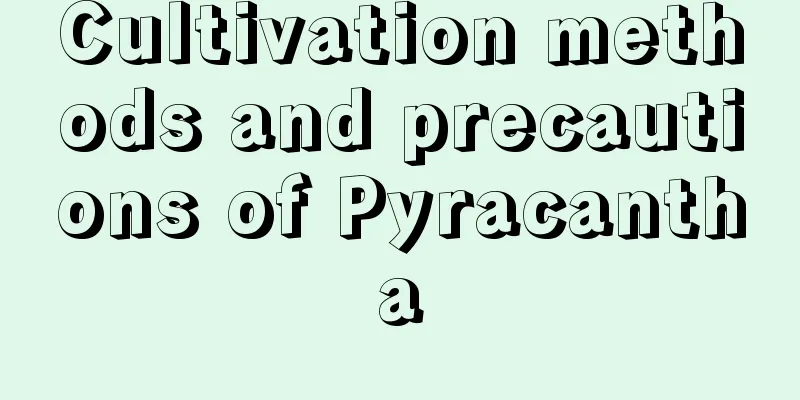Cultivation methods and precautions of Pyracantha

Farming methodsPyracantha likes a warm and humid environment. Pay attention to ventilation at all times, otherwise it will easily cause Pyracantha diseases. Pyracantha grows best in an environment with a temperature of 20~30°C. It requires sufficient light and should be given a longer sunshine time. Pyracantha is relatively cold-resistant and can easily survive the winter. If the temperature of the environment in which Pyracantha grows is too high in winter, it will affect the flowering and fruiting of Pyracantha in the second year. Pyracantha has low requirements for soil, but in order for the Pyracantha plant to grow well, you should choose sandy soil with a deeper soil layer, looser soil and better drainage for planting. Normally, you can apply some nitrogen fertilizer regularly to promote the growth of Pyracantha branches and leaves. When the flowering period is about to begin, you can apply some phosphorus fertilizer and potassium fertilizer to promote the prosperity of the flowering period and promote the ripening of the fruit. No fertilizer is needed in winter to allow Pyracantha to pass its dormant period. Pyracantha is very drought-resistant, but the soil tends to dry out in winter, so you can water it appropriately. During the flowering period, the soil can be kept relatively dry, which is good for the fruiting of Pyracantha. If the flowering period coincides with the rainy season, pay attention to drainage. After harvesting the fruits and before entering the dormant period, water the plants enough for the winter, and then no watering is required during the dormant period. Pyracantha is generally propagated by two methods: seed propagation and cuttings. PrecautionsWhen planting Pyracantha, we must pay attention to preventing diseases and insect pests of Pyracantha. If Pyracantha is planted in an environment with poor ventilation, it will easily be infected by fungi, causing powdery mildew, leaf spot, rust and other diseases. Therefore, we must maintain ventilation, provide Pyracantha plants with sufficient light, and spray them with medicines such as Benomyl in time when the disease occurs. Aphids are more likely to appear in spring, and Pyracantha is also prone to pests such as the pear-crowned bug. We must discover them early and apply relevant pesticides as soon as possible to kill the pests. Pyracantha also needs pruning, because the crown of Pyracantha is very messy in its natural state, which not only affects the growth of Pyracantha, but also affects the results of Pyracantha, so we have to prune overly dense branches, overgrown branches, thin branches, etc. every year. When the flowering period is approaching, be sure to prune branches with too many flower buds. Pyracantha is very fond of water and fertilizer, so the soil of potted Pyracantha should be changed and the pot should be repotted every two years to maintain the fertility of the potting soil. |
<<: These large green plants with great meanings must have a pot at home
Recommend
How to cultivate catalpa
1. Maintenance methods 1. Temperature: Its normal...
Will eating pumpkin make you fat? What are the advantages and disadvantages of eating pumpkin?
1. Will eating pumpkin make you fat? Eating pumpk...
Can sweet elephant grass be planted in the north? Grass growth environment and climate requirements
Sweet elephant grass Sweet elephant grass can be ...
The difference between lotus and lotus
Lotus is the lotus The two are the same plant, no...
The reason why the leaves of the fiddle-leaf fig droop and how to save it
1. Reasons for leaf drooping 1. Soil compaction: ...
How to propagate thyme
Three ways to propagate thyme sowing The time for...
How to Propagate Torch Ginger
1. Division propagation If you want to divide the...
The cultivation methods and precautions of the succulent Wanchongshan
The succulent plant Wanchongshan is very easy to ...
What is the best way to water Impatiens?
Impatiens , also known as henna, daughter flower ...
How to propagate keel flower
1. Operation method 1. Pruning. First, cut the br...
How many kilograms of peanuts are produced per mu?
Peanut yield per mu The annual yield per mu of pe...
What soil is best for growing red bud maple (bonsai cultivation method for red bud maple)
What kind of soil is suitable for planting red bu...
Taboos on the placement of the lucky bamboo, Feng Shui of the placement of the lucky bamboo
1. Taboos of placement When raising the Chinese r...
Should I put green ivy or spider plant in my bedroom? What are the effects and differences? Which one is better for Feng Shui?
1. What to put Both of these are common plants in...
Late watermelon planting time and method
Late watermelon planting time Late watermelon can...









